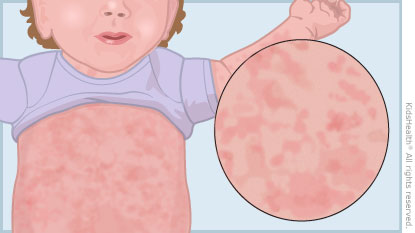Roseola (roe-zee-OH-lah) is a viral infection that mostly affects children 6 months to 2 years old. It causes a high fever followed by a rash when the fever breaks. The infection usually gets better in about a week. Here are some ways to keep your child comfortable and hydrated.



Your child:

Your child:

What happens with roseola? Roseola (also known as sixth disease, exanthem subitum, and roseola infantum) begins with a high fever — often over 103°F (39.4°C) — that lasts for 3–5 days. When the fever goes away, a pinkish-red rash starts on the trunk that can last up to 3 days. The rash often spreads to the neck, face, arms, and legs.
Can roseola cause other symptoms? Many children with roseola get swollen lymph nodes (glands) in the neck and lose their appetite; some have cold symptoms and are fussy. A few children may have febrile seizures (convulsions caused by a high temperature) during the fever phase.
Can roseola spread to others? Yes. Because roseola is caused by a virus, it can be contagious. It is not contagious by the time the rash breaks out.